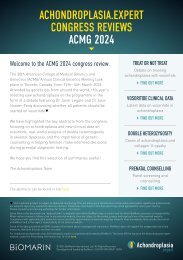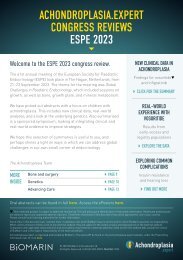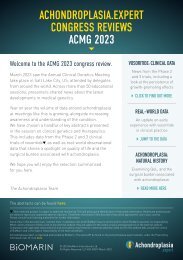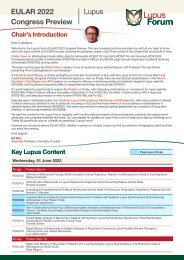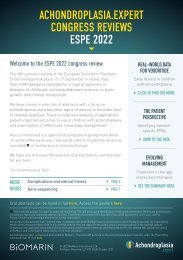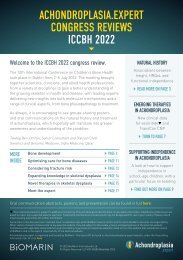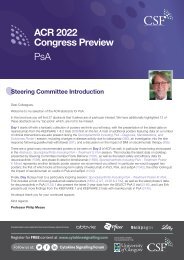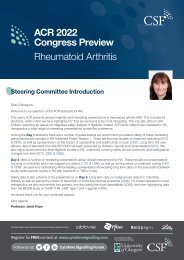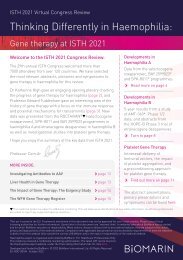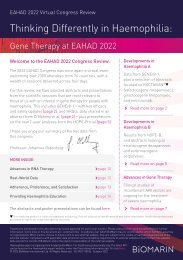ISTH 2022 Congress Review
You also want an ePaper? Increase the reach of your titles
YUMPU automatically turns print PDFs into web optimized ePapers that Google loves.
<strong>ISTH</strong> <strong>2022</strong> <strong>Congress</strong> <strong>Review</strong><br />
Thinking Differently in Haemophilia:<br />
Gene Therapy at <strong>ISTH</strong> <strong>2022</strong><br />
Welcome to the <strong>ISTH</strong> <strong>2022</strong> <strong>Congress</strong> <strong>Review</strong>.<br />
The <strong>ISTH</strong> is dedicated to advancing the understanding,<br />
prevention, diagnosis, and treatment of conditions related to<br />
thrombosis and haemostasis – and has over 7,000 clinicians,<br />
researchers, and educators working together to improve the<br />
lives of patients around the world.<br />
For this review, we have selected abstracts and presentations<br />
with a focus on gene therapy for people with haemophilia. This<br />
includes new vector shedding data from GENEr8-1 [page 5],<br />
and a QoL analysis from HOPE-B [page 6]. We also bring you<br />
a wealth of new information and advances in gene therapy<br />
technology and engineering, offering a tantalising glimpse<br />
of the novel therapies that could be next over the horizon.<br />
I hope you enjoy our summary of the key data.<br />
Professor Charles Hay<br />
MORE INSIDE:<br />
Clinical data: Gene therapy for haemophilia A page 4<br />
Clinical data: Gene therapy for haemophilia B page 6<br />
Immunogenicity of gene therapy page 8<br />
Factor replacement and other therapies page 18<br />
The WFH GTR<br />
Long-term follow-up<br />
for gene therapy.<br />
Read more on page 2<br />
Evolving clinical practice<br />
International accreditation<br />
and safe-guarding quality.<br />
Read more on page 2<br />
The future of gene therapy<br />
Advances in engineering<br />
and gene editing.<br />
Read more on page 9<br />
Bleeding tendencies<br />
in haemophilia<br />
Understanding the<br />
bleeding phenotypes.<br />
Read more on page 16<br />
The poster presentations and<br />
abstracts can be found here<br />
This medicinal product is subject to additional monitoring. This will allow quick identification of new safety information. Healthcare professionals<br />
are asked to report any suspected adverse reactions.<br />
Treatments mentioned in this document may not be approved for use in your country. Please consult local licensing authorities for further<br />
information. Some links in this document are “external links” to websites over which BioMarin has no control and for which BioMarin assumes<br />
no responsibility. When visitors choose to follow a link to any external website, they are subject to the cookie, privacy and legal policies of the<br />
external website. Compliance with applicable data protection and accessibility requirements of external websites linked to from this website<br />
falls outside the control of BioMarin and is the explicit responsibility of the external website.<br />
HaemDifferently.expert is organised and funded by BioMarin. For Healthcare Professionals Only.<br />
The latest API can be found on the HaemDifferently.expert website, under the Prescribing<br />
Information tab. Or click here. Developed and funded by BioMarin.<br />
© <strong>2022</strong> BioMarin International Ltd. All Rights Reserved. EU-ROC-00183 October <strong>2022</strong><br />
1
<strong>ISTH</strong> <strong>2022</strong> <strong>Congress</strong> <strong>Review</strong><br />
Long-term follow-up for gene therapy<br />
Registry collaborations are an effective way to pool enough data to enable<br />
robust evaluation of rare AEs and durability of gene therapy. Linking<br />
registries is an extensive process involving many steps and collaboration<br />
among multiple partners.<br />
The WFH GTR is a prospective, observational,<br />
and longitudinal registry. The core data set<br />
was developed through an iterative review<br />
process by the GTR Steering Committee.<br />
To maximise the utility of data in existing<br />
registries – and avoid the need for duplicate<br />
data entry at individual HTCs – the WFH GTR<br />
includes a data integration programme.<br />
Collaboration has already begun with the<br />
American Thrombosis and Hemostasis<br />
Network, HemoNed, and the Canadian<br />
Bleeding Disorders Registry. Common data<br />
definitions were set, and careful comparison<br />
of data field measurements conducted to<br />
facilitate the technical mapping of data fields<br />
between the GTR and partner registries;<br />
de-identified data will now be transferred<br />
to the GTR on a regular basis. The GTR and<br />
partner registries will help establish longterm<br />
follow-up as the standard of care for<br />
gene therapy, and discussions on potential<br />
integrations with other national registries are<br />
ongoing. The WFH GTR will ensure that rare<br />
AEs will be detected in a small population<br />
over a large geographical area. The GTR will<br />
also help further establish long-term followup<br />
as the standard of care for gene therapy.<br />
[PB0212]<br />
possibilities, including gene therapy. A tight<br />
network of centres structured along a huband-spoke-model<br />
will address all aspects of<br />
gene therapy, from dosing and surveillance in<br />
the immediate post-infusion period, to longterm<br />
follow-up. The content and logistics of<br />
the multidisciplinary auditing and certification<br />
procedures are in development, and it is<br />
expected that the auditing process will begin<br />
in 2023. [PB1127]<br />
In a session on health literacy in the nurses’<br />
forum, there was a presentation outlining the<br />
development of a new educational tool for use<br />
on the <strong>ISTH</strong> website. The role of the nurse in<br />
haemophilia care is to educate, guide, and<br />
support patients. The advent of gene therapy<br />
is likely to create a new class of patient who<br />
has shifted from a severe to mild phenotype,<br />
and who will therefore need a different<br />
management approach. In the future, the<br />
role of the haemophilia nurse is likely to<br />
require a greater emphasis on psychosocial<br />
support for gene therapy patients. Inherently,<br />
there are challenges for incorporating gene<br />
therapy into clinical practice, with issues of<br />
patient information, selection, education,<br />
and consent. There are also practical<br />
considerations for preparation, storage,<br />
and administration, as well as the need for<br />
monitoring and laboratory investigations.<br />
Communication with patients and caregivers<br />
remains key. The new <strong>ISTH</strong> educational<br />
tool is designed for nurses and includes an<br />
introduction to gene therapy for haemophilia<br />
– from basic terms and concepts to trial data<br />
and frequently asked patient questions. The<br />
tool uses an adaptive e-learning approach<br />
to help contribute to a holistic approach and<br />
to promote the acquisition of knowledge.<br />
Further e-learning modules available on the<br />
site include emerging nonfactor approaches<br />
for people with haemophilia. [NUR 02]<br />
Haemophilia: Evolving clinical practice<br />
The Changing Role of Nurses<br />
Role of nurses shift<br />
from teacher to coach<br />
Gene therapy represents a fundamental shift in the treatment of haemophilia,<br />
but the approach differs significantly from all other current treatment<br />
protocols and presents a challenge for both medical staff and centres.<br />
New normal:<br />
Patients adjusting<br />
to a mild phenotype<br />
Inform the patient and<br />
explain their treatment<br />
The international accreditation of haemophilia<br />
centres in Europe is run by EAHAD and EHC.<br />
Centres are designated as EHCCC or EHTC<br />
based on specific requirements that evaluate<br />
their ability to provide care for haemophilia<br />
and allied disorders. Boban et al. presented a<br />
poster on the novel accreditation of European<br />
haemophilia treatment and gene therapy<br />
centres. EAHAD, in collaboration with EHC,<br />
have taken steps to define measures to<br />
safeguard and improve the quality of care for<br />
bleeding disorders care throughout Europe,<br />
to build a novel model for implementation of<br />
gene therapy, and to provide a new auditing<br />
and certification protocol. Haemophilia<br />
centres are organised to offer multidisciplinary,<br />
integrated, and comprehensive<br />
care – as well as equal access to all treatment<br />
More visits<br />
with a new treatment<br />
vs standard of care<br />
Requires<br />
confidence and trust<br />
in the body and mind<br />
React and treat<br />
vs wait and see<br />
Be present at all times<br />
and explore how the<br />
patient is feeling<br />
Mulders-van der Meer [NUR02]<br />
2 3
<strong>ISTH</strong> <strong>2022</strong> <strong>Congress</strong> <strong>Review</strong><br />
Clinical data: Gene therapy for<br />
haemophilia A<br />
Several gene therapies in development continue to collect efficacy, safety,<br />
and QoL data after a single infusion in people with haemophilia A.<br />
Haemostatic results for up to 6 years<br />
following treatment with a single infusion of<br />
ROCTAVIAN ® (valoctocogene roxaparvovec)<br />
were presented by Laffan et al. ROCTAVIAN ®<br />
is indicated for the treatment of severe<br />
haemophilia A in adult patients without a<br />
history of factor VIII inhibitors and without<br />
detectable antibodies to AAV5. Please read<br />
the ROCTAVIAN ® SmPC before prescribing.<br />
In the Phase 1/2 trial, all participants showed<br />
sustained improvements in FVIII activity, ABR,<br />
and use of exogenous FVIII. Updated, detailed<br />
safety and efficacy assessments from 6-year<br />
follow-up data from the 6x10 13 vg/kg cohort<br />
and 5-year follow-up data from the 4x10 13 vg/kg<br />
cohort were shared, showing a sustained<br />
reduction in treated bleeds in both groups.<br />
Haemostatic efficacy was maintained for<br />
12 of 13 participants over the study period,<br />
and the 7 participants dosed with 6x10 13 vg/kg<br />
demonstrate ongoing haemostatic efficacy<br />
without routine prophylaxis 6 years postgene<br />
transfer. In the 4x10 13 vg/kg cohort,<br />
one participant resumed FVIII prophylaxis<br />
for 1 month during Year 5, and is currently<br />
using on-demand treatment, with no need<br />
for FVIII infusions over the past 20 weeks.<br />
Mean annualised FVIII infusion rate over entire<br />
study observation period remained low, with a<br />
96% and 93% reduction from baseline in the<br />
6x10 13 and 4x10 13 vg/kg cohorts, respectively,<br />
and previously observed trends regarding<br />
change in FVIII activity were maintained.<br />
Mean QoL was maintained (4x10 13 vg/kg<br />
cohort) or improved (6x10 13 vg/kg cohort) over<br />
the study period, with individual variation. With<br />
regards safety, there was one event of parotid<br />
acinar cell carcinoma – but genomic analyses<br />
supported initial assessment of this event<br />
as unrelated to valoctocogene roxaparvovec.<br />
Overall, the safety profile remains unchanged<br />
from previous reports. [OC 21.2]<br />
Liu et al. presented comparative effectiveness<br />
of valoctocogene roxaparvovec and FVIII<br />
prophylaxis, estimated through propensity<br />
scoring. The aim of this post-hoc analysis<br />
was to compare bleeding outcomes among<br />
adults with severe haemophilia A treated<br />
with valoctocogene roxaparvovec versus<br />
prophylactic FVIII replacement. Data from<br />
112 participants who rolled over into GENEr8-1<br />
were compared to 73 participants enrolled<br />
in a prospective noninterventional study who<br />
were negative for FVIII inhibitors, anti-AAV5<br />
antibodies, and HIV. Comparable cohorts<br />
were generated based on propensity scores<br />
using standardised mortality ratio weighting<br />
to weight the control cohort to match baseline<br />
characteristics of the intervention cohort.<br />
The analysis found that mean treated and<br />
all-bleeds ABR were significantly lower in<br />
the intervention versus control cohort, with<br />
an absolute difference of –3.6 (P
<strong>ISTH</strong> <strong>2022</strong> <strong>Congress</strong> <strong>Review</strong><br />
Gonen-Yaacovi et al. showed the design for a<br />
clinical study of ASC618 – a highly potent and<br />
minimally sized vector containing a hepatic<br />
combinatorial bundle promoter, liver-specific<br />
codon optimisation, and a highly expressing<br />
bioengineered human FVIII (ET3) transgene,<br />
designed to express FVIII protein for the<br />
treatment of severe and moderately severe<br />
haemophilia A. In preclinical studies, ASC618<br />
was well tolerated at all doses evaluated with<br />
Clinical data: Gene therapy for<br />
haemophilia B<br />
no toxicologically significant microscopic<br />
findings. Now, the safety, tolerability and<br />
preliminary efficacy will be assessed in a<br />
prospective clinical study. The decision of<br />
dose escalation versus dose expansion in<br />
each cohort will be based on FVIII levels<br />
and safety evaluations. Following infusion,<br />
patients will be closely monitored for FVIII,<br />
ALT, and AST for up to 5 years post-infusion.<br />
[PB0662]<br />
Breakthrough bleeding still occurs with many replacement therapies.<br />
Achieving FIX levels after gene therapy is expected to normalise haemostasis<br />
in people with haemophilia B.<br />
Steve Pipe presented the abstract from<br />
Itzler et al. on HRQoL data from the Phase<br />
3 HOPE-B trial. Fifty-four adults with<br />
haemophilia B (FIX ≤2%) received standard<br />
of care FIX concentrate prophylaxis in the<br />
6-month lead-in period followed by a single<br />
infusion of etranacogene dezaparvovec.<br />
Quality of life was a prespecified secondary<br />
endpoint, and HRQoL was assessed with the<br />
haemophilia-specific Hem-A-QoL during<br />
lead-in, and again at 6 and 12 months –<br />
alongside other patient-reported outcomes.<br />
The results showed significant modelbased<br />
mean differences in both scores<br />
and percentage improvement compared<br />
with the lead-in period, including a<br />
total score change of –5.50 (P
<strong>ISTH</strong> <strong>2022</strong> <strong>Congress</strong> <strong>Review</strong><br />
Immunogenicity of gene therapy<br />
Immune responses to gene therapies have been associated with infusion<br />
reactions, liver enzyme elevations, and loss of transgene expression.<br />
The predominant AE in clinical trials of<br />
AAV-based gene therapy for haemophilia<br />
has been ALT elevation. Although capsiddirected<br />
cytotoxic T-cell responses have<br />
been reported, the underlying mechanisms<br />
remain unclear. Batty et al. shared data on<br />
innate and adaptive immune responses to<br />
AAV gene therapy in a canine model. Severe<br />
haemophilia A dogs (N=10) were treated<br />
using one of three AAV5-BDD FVIII constructs<br />
with a hybrid liver promoter (AAV5-HLPcFVIII).<br />
Capsid immune responses were<br />
evaluated using total antibody and ELISPOT<br />
assays, and serum innate immune responses<br />
were evaluated using a cytokine array and<br />
complement function. Liver biopsies were<br />
used to quantify vg copies and cFVIII mRNA<br />
at baseline and 3 months. The results showed<br />
FVIII expression for the 7 dogs treated with<br />
codon-optimised constructs. Dose response<br />
was seen at 3 months, with higher one-stage<br />
FVIII:C in the high-dose compared to lowdose<br />
cohort. Liver biopsies demonstrated<br />
AAV5-HLP-cFVIII in all animals, with<br />
correlation between vg and cFVIII mRNA<br />
copies. Anti-AAV5 capsid antibodies were<br />
detected starting Day 7 post-treatment,<br />
and no new FVIII inhibitors were detected.<br />
The dogs displayed variable serum cytokine<br />
profiles, with no change in mean levels<br />
24 hours post-dosing, and no blood<br />
biomarkers of innate immune activation<br />
detected. Higher baseline and post-dose<br />
levels of TNF-alpha, IL-2, IL-6, IL-7, IL-15,<br />
and IL-18 were observed in the dog with a<br />
FVIII inhibitor history. No capsid-specific<br />
T-cell responses or complement activation<br />
was detected. Further liver studies<br />
are ongoing. [OC 01.5]<br />
Chapin et al. gave the results of a<br />
translational analysis of immune components<br />
in peripheral blood from severe haemophilia<br />
A patients treated with TAK-754 (formerly<br />
BAX 888) – an AAV8 vector with a<br />
codon-optimised BDD FVIII transgene.<br />
Cell-mediated cytotoxic T cell responses<br />
in peripheral circulation have been reported<br />
in clinical trials but have not consistently<br />
correlated with transaminase elevation<br />
and loss of transgene expression. The<br />
aim of this analysis was to report clinical<br />
biomarkers of immunogenicity and present<br />
an immunogenicity transcriptomics analysis<br />
from peripheral blood of treated patients.<br />
Results showed no changes in cytokines<br />
within 24 hours of infusion. Transaminase<br />
elevation and decline of FVIII expression<br />
occurred 4–9 weeks post-infusion despite<br />
use of glucocorticoids. No significant changes<br />
in complete blood count populations were<br />
observed. ELISpot assays did not correspond<br />
with loss of FVIII transgene expression or<br />
transaminase elevation, and bulk mRNA<br />
transcriptomic analysis did not demonstrate<br />
significant changes in dendritic or natural<br />
killer cells, NF-κB, IL-6, TLRs 1–8, or T cell<br />
pathway signals. Furthermore, a small<br />
transient increase in TLR9, TNF-alpha, CCL5,<br />
and IRF7 signals occurred 8 hours after<br />
infusion without activating a Type 1 interferon<br />
response. The authors concluded that<br />
TAK-754 evokes a limited immune response<br />
as measured in blood – demonstrating that<br />
such methods have limited value for clinical<br />
decision-making or post-hoc analysis.<br />
Efforts to optimise AAV gene therapy should<br />
focus on targeting tissue-specific analysis<br />
and improving preclinical immunogenicity<br />
models. [PB0211]<br />
It has previously been suggested that<br />
elimination of N-glycosylation in C1 domain<br />
reduces the immunogenicity of gene therapy,<br />
and that a glycoepitope may exist in the<br />
C1 domain. Fan et al. examined the impact<br />
of FVIII glycosylation following AAV-mediated<br />
gene therapy, with the aim of further<br />
characterising the immunogenic glycoepitope<br />
The future of gene therapy<br />
region. Haemophilia A mice were injected<br />
with AAV-FVIII and AAV-N2118Q, followed by<br />
challenge with repeated FVIII injections. FVIII<br />
expression was initially detected in all treated<br />
mice for 8 weeks; however, this subsequently<br />
dropped to very low or undetectable at Week<br />
12 in the BDD group but was only slightly<br />
decreased in the N2118Q group. Following<br />
FVIII challenge, the N2118Q-treated mice<br />
showed higher resistance to inhibitor<br />
formation than those in the BDD group.<br />
Higher proliferation rates or cytokine levels<br />
were detected in mouse cells and human<br />
PBMCs isolated from inhibitor subjects<br />
cultured with MP1 and MP2, but not with MP3<br />
or non-mannosylated peptides. Cells from<br />
non-inhibitor control subjects did not exhibit<br />
increased proliferation when stimulated with<br />
any peptides. [OC 47.5]<br />
Gene therapy is in its infancy, and many new approaches are in development<br />
to enhance and improve the delivery and specificity of transgenes.<br />
In a state-of-the-art session, Elena<br />
Barbon presented on engineering of AAV<br />
to enhance cell-specific transduction.<br />
AAV are commonly used viral vectors for<br />
gene therapy since they are replication<br />
defective, but despite promising clinical<br />
results, challenges remain for AAV-directed<br />
gene therapy, including immunity to the<br />
virus in the general population, which may<br />
affect the widespread applicability of AAVbased<br />
therapeutics. There are also questions<br />
around re-injection of the vector, and dilution<br />
in paediatric patients. Additionally, the<br />
platform cannot accommodate very large<br />
transgenes. There is a need to improve the<br />
AAV vector to give improved transduction<br />
efficiencies, which may ultimately allow<br />
a lower dose, and consequently result<br />
in lower immunogenicity, and reduced<br />
neutralisation by pre-existing antibodies. Key<br />
engineering strategies include site-directed<br />
mutagenesis, capsid shuffling, and peptide<br />
insertion. Dr Barbon showed data from<br />
AAV2 vectors devoid of multiple surfaceexposed<br />
tyrosine, suggesting efficient<br />
transduction and correction of phenotype in<br />
haemophilia B mice, as well as results from<br />
experiments with capsid shuffling technology.<br />
8 9
<strong>ISTH</strong> <strong>2022</strong> <strong>Congress</strong> <strong>Review</strong><br />
The conclusions noted that AAV capsid<br />
engineering – together with rational design<br />
of vector genomes – are valuable strategies<br />
that may be able to address several issues<br />
with gene therapy. A challenge remains in<br />
translating the results, due to differences in<br />
serotype, cell types, and the in vivo models<br />
used for validation. [SOA 15.1]<br />
Peter Lenting gave a talk on the use of<br />
nanobodies to enhance AAV targeting. One<br />
possible use may be in the purification of<br />
AAV particles. The advantage is that this is<br />
a one-step purification, with yield greater<br />
than 70%. However, the nanobodies cannot<br />
distinguish between empty and loaded<br />
virions, and are more expensive than other<br />
purification techniques. Also, it is unknown<br />
how the AAV affinity for nanobodies might<br />
affect the transgene. Since not all cell types<br />
can be infected with AAV, and off-target<br />
transduction may have unexpected results,<br />
nanobodies may improve cell-specific<br />
targeting. There are two proteins on the<br />
AAV capsid in a ratio of 1:10, and which are<br />
encoded by a single gene. To improve cellspecificity,<br />
it is possible to knock out one of<br />
the AAV binding sites and introduce a new<br />
one by leveraging a non-functional part of<br />
the protein loop. A further advantage is that<br />
nanobodies are very small, so they do not<br />
increase the size of the transgene beyond<br />
the vector capacity. Nanobodies are also<br />
characterised by low immunogenicity and<br />
can be expressed as intracellular proteins<br />
(intrabodies) – which opens up the possibility<br />
of intracellular targets. [SOA 15.2]<br />
Tonetto et al. presented on base- and<br />
prime editing of DNA as a new therapeutic<br />
option for haemophilia A. Recently, DNA<br />
base- and prime editing approaches that<br />
do not rely on HSR have been developed<br />
to cleanly install or revert point mutations.<br />
The group used cellular models created by<br />
expression of recombinant FVIII variants.<br />
The aim was to correct representative F*<br />
missense and nonsense variants at the DNA<br />
level, thus rescuing FVIII expression. The<br />
results showed that in transient and stable<br />
expression systems, c.6046C>T(p.R2016W),<br />
c.6496C>T(p.R2166*), c.6545G>A(p.R2182H),<br />
c.6682C>T(p.R2228*), and c.6683G>A(p.<br />
R2228Q) led to reduced secreted FVIII<br />
levels, while the p.R2228* change produced<br />
appreciable FVIII protein levels attributable to<br />
a truncated isoform. Screening of large sets<br />
of base- and prime edited variants and guide<br />
RNAs identified combinations that rescued<br />
FVIII secretion for the p.R2166, p.R2182H,<br />
and p.R2228Q mutations. Extensive studies<br />
on the p.R2166* and p.R2228Q changes<br />
demonstrated that the reversion of mutations<br />
– detectable at DNA levels – resulted in<br />
appreciable rescue of secreted FVIII protein<br />
and activity levels (up to 20% of FVIII-WT).<br />
This is the first time that a base- and<br />
prime editing approach has been applied to<br />
haemophilia A and provides the proof-ofprinciple<br />
for the efficacy of base editing in<br />
cellular models. Further studies in BOECs<br />
are currently in progress, and will lay the<br />
foundation for studies in animal models<br />
– which might open a new avenue toward<br />
an innovative and personalised cure for<br />
haemophilia A. [OC 01.1]<br />
Ultrasound-mediated gene delivery with<br />
microbubbles is a potentially effective<br />
method of non-viral gene delivery to treat<br />
haemophilia A. Previous studies have found<br />
LSECs could be targeted at a lower power<br />
than hepatocytes. Lawton et al. hypothesised<br />
that gene expression with lower energy<br />
conditions would be comparable to higher<br />
energy conditions, but with less damage to<br />
the liver or induction of anti-FVIII inhibitors.<br />
Mouse liver was injected via the portal vein<br />
with a combination of plasmid DNA and<br />
microbubbles. Simultaneously, a pulsed<br />
therapeutic ultrasound transducer was<br />
applied to the liver surface for 1 minute<br />
at 1.1 MHz frequency and 14 Hz PRF.<br />
Haemophilia A mice were separated into<br />
two different ultrasound condition groups:<br />
low energy targeting predominantly<br />
endothelial cells, or high energy targeting<br />
predominantly hepatocytes. A highexpressing,<br />
endothelial-specific hFVIII<br />
plasmid (pUCOE-ICAM2-hF8/N6-X10) was<br />
used. FVIII activity levels for both energy<br />
groups stabilised around 10% at 84 days<br />
post-treatment. Fluorescent staining showed<br />
co-localisation of hFVIII and Lyve-1 at Days 7<br />
and 120. Transaminase levels indicated the<br />
low energy group had lower transient liver<br />
damage than the high energy group in the<br />
first week, with both groups returning to<br />
baseline by Week 2. These findings show that<br />
LSECs can be targeted for transfection using<br />
lower energy than previously established, and<br />
that this approach can produce FVIII activity<br />
over 84 days. The ability to target different<br />
cell types with ultrasound-mediated gene<br />
delivery may be useful in a multitude of<br />
genetic conditions. [OC 12.5]<br />
Among all mutations causing haemophilia<br />
A, those affecting splicing are relatively<br />
frequent – particularly in severe forms.<br />
These mutation types, often leading to<br />
exon skipping, can be rescued by RNA<br />
therapeutics based on variants of the key<br />
U1snRNA spliceosomal component, as<br />
shown in several human disease models.<br />
Peretto et al. discussed the rescue of an FVIII<br />
splicing variant with engineered U1snRNAs<br />
in two brothers with moderate haemophilia<br />
A. Bioinformatic analysis did not predict an<br />
impact on splicing for the F8 c.1752+5g>c<br />
mutation; however, splicing pattern analysis<br />
of the hepatoma cells expressing the<br />
pIVS11+5c variant revealed that the change<br />
leads to exon 11 skipping, with low levels<br />
of correctly spliced transcripts (~10 %).<br />
Co-transfection of U1snRNA variants<br />
improved FVIII exon 11 definition and thus<br />
inclusion, with the compensatory U1snRNA<br />
associated with exon 11 inclusion up to 92%.<br />
This study provides experimental evidence<br />
that the c.1752+5g>c mutation impairing<br />
F8 exon 11 leads to exon skipping with trace<br />
levels of correct transcripts. Importantly,<br />
the defective exon can be restored with<br />
appropriately designed U1snRNA variants,<br />
which are currently under investigation<br />
through lentiviral-mediated delivery in BOECs<br />
isolated from patients with haemophilia A.<br />
[OC 21.1]<br />
Treatment of canine haemophilia A via<br />
intraosseous delivery of an FVIII lentiviral<br />
vector was showcased by Rementer et al.<br />
The vector – incorporating a platelet-specific<br />
promoter Gp1bα and canine FVIII gene – was<br />
injected into the tibia or iliac bones of four<br />
dogs with haemophilia A. Prior to injection,<br />
the dogs were treated with an immune<br />
modulation regimen to minimise immune<br />
response. Following the procedure, blood<br />
samples were taken at various timepoints.<br />
All dogs recovered well from the procedure<br />
and had blood chemistry values within<br />
normal ranges. Expression of cFVIII was<br />
10 11
<strong>ISTH</strong> <strong>2022</strong> <strong>Congress</strong> <strong>Review</strong><br />
examined in platelets and plasma by ELISA<br />
and aPTT assays. Canine FVIII was detected<br />
in platelets, with the highest expression at<br />
5–10 mU/10 8 platelets around 1–2 months<br />
post-procedure. Expression persisted for<br />
the duration in all treated dogs. FVIII was<br />
not detected in the plasma following perioperative<br />
delivery, indicating that it is not<br />
released into the plasma. The correction of<br />
the haemophilia phenotype was evaluated<br />
by WBCT, which was shortened in multiple<br />
time points soon after intraosseous gene<br />
therapy, indicating improved haemostasis.<br />
Furthermore, the therapy was well tolerated<br />
and did not produce any toxicity, as evaluated<br />
by CBC and blood chemistry analysis,<br />
and only one animal developed anti-FVIII<br />
inhibitors, which decreased over time.<br />
Encouragingly, the dogs experienced fewer<br />
bleeding events per year after gene therapy<br />
treatment compared with the baseline<br />
prior treatment. This study demonstrates<br />
a potential strategy for safe and effective<br />
application of gene therapy in vivo for treating<br />
people with haemophilia A. [OC 21.3]<br />
Lima et al. shared their work on the<br />
development of a viral vector for haemopexin<br />
protein expression for gene therapy in<br />
disorders associated with increased levels<br />
of free extracellular heme. Haemopexin is<br />
responsible for removing free heme from<br />
the circulation and has been shown to be<br />
depleted in haemolytic diseases. An AAV-<br />
8 vector was produced containing the full<br />
cDNA sequence of human haemopexin; this<br />
was injected into mice with escalating doses<br />
of 2×10 12 , 1×10 13 and 2×10 13 vg/kg, while<br />
a control group received an empty vector.<br />
Expression was confirmed in liver samples<br />
obtained after 6 weeks, and functional<br />
activity assessed by heme challenge and<br />
phenylhydrazine-induced haemolysis.<br />
Overall, sustained expression of human<br />
haemopexin was observed up to 58 weeks<br />
in plasma. Expression was dose-dependent<br />
and not associated with clinical signs of<br />
toxicity. Levels of human haemopexin were<br />
significantly reduced by heme infusions and<br />
phenylhydrazine-induced haemolysis. There<br />
was no clinical toxicity or laboratory signs of<br />
liver damage in these preliminary short-term<br />
studies of heme challenge. Additional studies<br />
are required to confirm the biological effect of<br />
the transgenic protein and its effect in animal<br />
models of chronic haemolysis. [PB0729]<br />
Due to the packaging constraints of the<br />
AAV vector, minimised promoter elements,<br />
such as hAAT/ApoE and TTR, have been<br />
developed to direct FVIII expression to the<br />
liver. Lindgren et al. presented their work to<br />
determine the cellular specificity of hAAT/ApoE<br />
and TTR promoters after systemic delivery<br />
of AAV8 vectors. AAV8-TTR-GFP (n=4)<br />
and AAV8-hAAT/ApoE-GFP (n=3) were<br />
administered to HA-CD4KO mice, and<br />
LSECs and hepatocytes analysed for GFP<br />
expression by flow cytometry. The results<br />
showed AAV8-TTR-GFP produce GFP in a<br />
similar proportion of hepatocytes and LSECs.<br />
Delivery of AAV8-hAAT/ApoE-GFP also<br />
resulted in GFP expression in both cell types;<br />
immunofluorescent staining confirmed the<br />
flow cytometry data. The findings suggest<br />
AAV8 constructs under control of minimised<br />
hAAT/ApoE and TTR promoter elements drive<br />
transgene expression in both hepatocytes<br />
and LSECs. Further studies are required to<br />
understand the biological consequences of<br />
FVIII expression in hepatocytes and LSECs<br />
after AAV-mediated gene therapy. [OC 12.1]<br />
New approaches in development:<br />
Gene editing<br />
Despite phenotypic improvement in clinical trials, universally sustained<br />
AAV-mediated Factor expression at levels necessary to eliminate bleeding<br />
has not been achieved, and many new approaches are in development –<br />
including gene editing.<br />
Sarangi et al. reasoned that a gene-editing<br />
strategy to introduce coagulation FVIIa into<br />
the host genome may augment haemostasis<br />
and alleviate the phenotype in haemophilia.<br />
A novel AAV vector was designed, containing<br />
mFVIIa to target the murine Rosa26 locus<br />
using CRISPR/Cas9-mediated gene editing.<br />
The novel triple vectors designed for<br />
expression of guide RNA, Cas9, and mFVIIa<br />
flanked by homology arms were validated by<br />
T7 endonuclease assay and HDR-genotyping<br />
and administered to haemophilia B mice.<br />
The functional rescue was assessed<br />
by coagulation function tests including<br />
prothrombin time assay, FVIIa activity, and a<br />
haemostatic challenge assay. The T7 assay<br />
revealed a cleavage efficiency of 20–42%,<br />
and further sequencing demonstrated the<br />
targeted integration of mFVIIa into the<br />
Rosa26 locus. The prothrombin time assay<br />
on 8-week samples showed a significant<br />
prothrombin reduction in mice that received<br />
the gene-editing vectors (22%), and a<br />
13% decline in mice that received only the<br />
AAV-FVIIa in comparison to the mock-treated<br />
animals; follow-up at 15 weeks showed a<br />
similar finding. Coagulation FVIIa activity in<br />
mice that received triple gene-editing vectors<br />
was around 4-fold higher than in the mock<br />
group. A tail-clip assay revealed a significant<br />
reduction of blood loss in mice injected with<br />
only FVIIa or gene editing vectors. Overall,<br />
this study shows long-term expression and<br />
phenotypic rescue with this novel geneediting<br />
strategy. [OC 12.2]<br />
Chen et al. looked at rescue of the<br />
endogenous FVIII expression in haemophilia<br />
A mice using CRISPR/Cas9 mRNA LNPs,<br />
which provide an efficient gene delivery<br />
system. LNPs carrying luciferase mRNA<br />
were examined for transfection efficiency<br />
in HepG2 and HUVEC cells. The efficiency<br />
of two sgRNAs was examined in vitro using<br />
a T7E1 assay. In vivo transfection efficiency<br />
was investigated by immunofluorescent<br />
staining of the liver following intravenous<br />
injection of GFP mRNA LNPs into the mice.<br />
Immunodeficient haemophilia A mice (NSG<br />
HA) with indel mutation in FVIII exon 1 were<br />
hydrodynamically injected with FVIII exon 1<br />
targeting sgRNA/Cas9 expressing plasmid.<br />
Subsequently, CRISPR/Cas9 mRNA LNPs<br />
were synthesised and intravenously injected.<br />
FVIII activity was examined by aPTT assay<br />
and gene editing verified by DNA sequencing.<br />
The results suggest that mRNA LNPs can<br />
efficiently transfect both HepG2 and HUVEC<br />
cells and can be delivered to hepatocytes<br />
and LSECs in vivo. NSG HA mice treated<br />
12 13
<strong>ISTH</strong> <strong>2022</strong> <strong>Congress</strong> <strong>Review</strong><br />
with sgRNA/Cas9 plasmids regained FVIII<br />
expression, and the subsequent CRISPR/<br />
Cas9 mRNA LNPs successfully induced indel<br />
mutation in mutant FVIII gene and rescued<br />
endogenous FVIII activity. In combination,<br />
these technologies have the potential to<br />
repair FVIII mutations and recover FVIII gene<br />
expression in patients with haemophilia A.<br />
[OC 12.3]<br />
Sternberg et al. investigated the safety and<br />
efficacy of FVIII-QQ for AAV-mediated gene<br />
therapy in CD4KO mice with haemophilia<br />
A (HA/CD4KO). FVIII:C was determined<br />
by CSA, and AAV-treated cohorts were<br />
followed for survival or analysed by tailclip<br />
assay. Recombinant hFVIII-WT or<br />
hFVIII-QQ was intravenously administered<br />
to immunocompetent haemophilia A mice<br />
weekly for 7 weeks, and Bethesdatiter<br />
determined. The vector dose EC50 and EC80<br />
of blood loss post tail-clip for AAV-hFVIII-QQ<br />
was 4.7- and 10-fold lower, respectively, than<br />
Assay discrepancies<br />
AAV-hFVIII-WT: supporting a 5- to 10-fold<br />
benefit of the hFVIII-QQ transgene. Ongoing<br />
studies of HA/CD4KO mice expressing<br />
hFVIII-WT and hFVIII-QQ in the mild and<br />
normal ranges of FVIII:C demonstrate no<br />
significant survival differences for at least<br />
3 months post-vector. Homozygous female<br />
and hemizygous male mice endogenously<br />
expressing FVIII-QQ via CRISPR-mediated<br />
gene editing were viable, fertile, and the<br />
same weight as their littermate controls.<br />
Immunocompetent haemophilia A mice<br />
treated with recombinant hFVIII-WT or<br />
hFVIII-QQ demonstrated expected inhibitor<br />
development that did not statistically differ.<br />
The authors conclude that these data<br />
demonstrate a haemostatic advantage<br />
of using the FVIII-QQ transgene for AAVmediated<br />
gene transfer. Preliminary murine<br />
safety studies did not demonstrate evidence<br />
of FVIII-QQ enhanced prothrombotic or<br />
immunological risk relative to FVIII-WT.<br />
[OC 12.4]<br />
Transgene-derived FVIII activity varies depending on whether it is<br />
measured with OSA or CSA. Understanding the mechanism of the<br />
discrepancy is necessary to determine which assay best represents<br />
in vivo haemostatic efficacy.<br />
AAV-mediated gene transfer trials in<br />
haemophilia A have demonstrated<br />
transgene-derived FVIII:C is around 2-fold<br />
higher by OSA than CSA; however, plasma<br />
FVIII antigen concentrations correlate with<br />
CSA-determined FVIII:C. The underlying<br />
mechanism is unclear – particularly since<br />
this is not observed with recombinant<br />
proteins of the same amino acid sequence.<br />
Possible hypotheses that may explain<br />
the OSA- versus CSA-determined FVIII:C<br />
discrepancy include enhanced activation, or<br />
differences in the function of the transgenederived<br />
FVIIIa species. Understanding the<br />
reason for this discrepancy will determine<br />
which assay best represents in vivo AAVderived<br />
FVIII haemostatic efficacy, and<br />
thereby patient management. Sternberg<br />
et al. shared their efforts to elucidate the<br />
mechanism behind AAV-derived FVIII assay<br />
discrepancies. To probe these mechanisms,<br />
AAV8-BDD-hFVIII was infused into male<br />
HA/CD4KO or HA/vWF-/- mice, and FVIII:C<br />
measured by OSA and CSA against a<br />
standard curve of recombinant BDD-hFVIII<br />
purified from BHK cells reconstituted in<br />
mouse plasma. TGA and two-stage clotting<br />
assays were also performed. As in humans,<br />
Gene therapy in juveniles<br />
the results showed that transgene-derived<br />
FVIII:C determined by OSA was around 2-fold<br />
higher than CSA-determined FVIII:C, and<br />
FVIII:Ag closely correlated with CSA FVIII:C.<br />
These data demonstrate that the discrepancy<br />
is not species-specific to humans and is not<br />
related to interactions with vWF. Interestingly,<br />
FVIII:C by the two-stage assay was higher for<br />
transgene-derived versus recombinant FVIII,<br />
suggesting FVIIIa derived from gene therapy<br />
has enhanced function relative to rFVIII.<br />
The group intend to repeat these experiments<br />
with human clinical samples to confirm<br />
their findings. [OC 01.3]<br />
The mass of the human liver doubles 8–9 months from birth, and again by<br />
3–4 years. Liver growth and expanding blood volume may reduce Factor levels<br />
in paediatric recipients of haemophilia gene therapy.<br />
Nichols et al. determined the effect of<br />
growth on FIX levels in male juvenile dogs<br />
with haemophilia B following treatment<br />
with an AAV-delivered, high-activity canine<br />
FIX-R338L. The animals received an<br />
AAV-encoding FIX-R338L variant under a liver<br />
specific promoter at age 3 (n=6) or 6 months<br />
(n=6) to model 2–6 or 6–12-year-old children,<br />
respectively. Body weight, liver size, clinical<br />
chemistries, and haemostatic activity were<br />
monitored by WBCT, thromboelastography,<br />
and aPTT. Dogs were followed for at least<br />
12 months, during a period of liver growth<br />
and blood volume expansion. Overall,<br />
treatment was well tolerated. To date,<br />
there have been no spontaneous bleeds<br />
post-treatment. Increasing vector dose was<br />
associated with progressive shortening of<br />
clotting times. Stable, durable reductions<br />
of WBCT, thromboelastography, and aPTT<br />
values were observed in all dogs, indicative<br />
of FIX activity. This durable efficacy was<br />
observed in growing juvenile dogs treated<br />
at an early age and was sustained for at<br />
least 1 year despite liver growth and blood<br />
volume expansion. [OC 21.4]<br />
14 15
<strong>ISTH</strong> <strong>2022</strong> <strong>Congress</strong> <strong>Review</strong><br />
Bleeding tendency in haemophilia<br />
Repeated bleeding in muscles and joints are major causes of morbidity and<br />
disability in people with haemophilia. Novel therapies, including modified<br />
replacement therapy and gene therapy, provide an opportunity to increase<br />
FVIII activity, or to correct haemostasis. Information on bleeding phenotype in<br />
haemophilia provides important information regarding the optimum target for<br />
prophylactic treatment.<br />
de Kovel et al. presented data from the<br />
PedNet study group, assessing bleeding<br />
according to baseline FVIII activity in 641<br />
children with non-severe haemophilia A.<br />
PedNet is a prospective, observational cohort<br />
study across 32 HTCs. Those taking part had<br />
baseline factor FVIII activity between 1–25%,<br />
and were followed from diagnosis until either<br />
01 January 2020, reaching 18 years, starting<br />
prophylaxis, or inhibitor diagnosis. Onset of<br />
bleeding and ABR were compared according<br />
to categories of baseline FVIII. The median<br />
age at first joint bleed was higher with<br />
increasing FVIII activity, but overall ABR was<br />
low, with 0.3 for all bleeds and 0.1 for joint<br />
bleeds. The authors conclude that children<br />
with non-severe haemophilia A have a low<br />
bleeding tendency. Onset of joint bleeding<br />
was delayed, and bleeding decreased with<br />
increasing FVIII levels. Bleeding rates<br />
approached zero at 16% for all bleeds, and<br />
6% for joint bleeds. A steep decrease in<br />
annual rates of joint bleeds was observed in<br />
patients with FVIII >2%. [PB0181]<br />
A post-hoc analysis of a non-interventional<br />
study from Camp et al. compared bleeding<br />
outcomes by prophylactic FVIII replacement<br />
intensity. Study BMN 270-902 collected realworld<br />
data on outcomes of a global cohort of<br />
people with severe haemophilia A receiving<br />
regular exogenous FVIII prophylaxis. The aim<br />
was to verify consistency in bleeding outcomes<br />
between those receiving high- and lowintensity<br />
prophylaxis. Among 194 participants,<br />
mean baseline annualised FVIII utilisation was<br />
5499.6 and 2838.0 IU/kg/year for high- and<br />
low-dose intensity cohorts, respectively, with<br />
a mean annualised FVIII infusion rate of 146.7<br />
and 120.2 infusions per year. Throughout<br />
follow-up the absolute difference in mean<br />
ABR for treated bleeds was 0.71 (P=0.4761),<br />
and the absolute difference in the proportion<br />
of participants with zero treated bleeds<br />
was 0.7% (34.6% versus 35.3%; P=0.7708).<br />
Similar trends were observed for all bleeds.<br />
The authors concluded that the intensity of<br />
prophylaxis did not impact bleeding outcomes<br />
in study BMN 270-902, since bleeding risks<br />
remain and were found to be similar across<br />
the cohorts irrespective of FVIII consumption.<br />
[PB0656]<br />
Markson et al. further explored the topic<br />
with a poster on medically recorded bleeds<br />
and healthcare resource use in the United<br />
States among men with haemophilia A.<br />
Adult males aged 19–64 years prescribed<br />
FVIII use during the on-study period<br />
Mean (SD) IU/kg/year<br />
8000<br />
7000<br />
6000<br />
5000<br />
4000<br />
3000<br />
2000<br />
1000<br />
0<br />
Annualized FVIII utilization<br />
5236.5<br />
High-dose<br />
prophylaxis<br />
(n = 78)<br />
P
<strong>ISTH</strong> <strong>2022</strong> <strong>Congress</strong> <strong>Review</strong><br />
Factor replacement and other therapies<br />
New data were presented for recombination Factor, and non-replacement<br />
products such as fitusiran.<br />
Berger et al. showcased data from GENA-99 –<br />
a prospective, multinational, non-interventional<br />
study looking at the safety and efficacy of<br />
simoctocog alfa in PTPs with haemophilia<br />
A in routine clinical practice. Males with<br />
haemophilia A (N=78) were enrolled in<br />
13 countries and followed for 100 exposure<br />
days. Over the course of the study, no patient<br />
experienced an ADR, and no inhibitors were<br />
reported. Of the 77 patients who received<br />
prophylaxis, 41.6% had a 3-times per week<br />
regimen, 23.4% were every-other-day,<br />
and 22.1% took their prophylaxis twice per<br />
week. In 74 patients who received at least<br />
3 months of prophylaxis, mean duration was<br />
10.2 months. Median ABR was comparable<br />
to those in the clinical registration studies<br />
(GENA-08 and GENA-03). In the 77 patients<br />
who received prophylaxis, there were 246<br />
breakthrough bleeding episodes; these were<br />
treated with simoctocog alfa, with a success<br />
rate of 88%. In the two patients treated ondemand,<br />
there were 55 bleeding episodes,<br />
98% of which were treated successfully with<br />
simoctocog alfa. The authors argue that<br />
these data indicate the long-term safety and<br />
efficacy of simoctocog alfa in the real-life<br />
setting are comparable to those in clinical<br />
registration studies, and the drug is effective<br />
and well-tolerated in patients of all ages in<br />
routine clinical practice. [PB1126]<br />
Fitusiran, an investigational siRNA<br />
prophylactic, targets antithrombin mRNA<br />
to rebalance haemostasis in people with<br />
haemophilia A or B, irrespective of inhibitor<br />
status. Srivastava et al. presented an analysis<br />
of two Phase 3 studies to consumption with<br />
fitusiran prophylaxis versus on-demand<br />
BPA/CFC in people with haemophilia – with<br />
or without inhibitors. Of 118 participants<br />
randomised to fitusiran, 19 received<br />
on-demand BPA, and 40 on-demand CFC.<br />
Total consumption of aPCC and rFVIIa was<br />
97.5% and 98.2% lower in the fitusiran versus<br />
the on-demand BPA arm, and overall mean<br />
consumption of FVIII and FIX was lower in the<br />
fitusiran versus on-demand CFC arm: 95.9%<br />
and 94.7%, respectively. The total number<br />
of treated bleeds was lower with fitusiran<br />
versus the on-demand BPA and CFC arms by<br />
82.0% and 79.2%, respectively. This analysis<br />
suggests that fitusiran prophylaxis reduced<br />
total BPA/CFC consumption by ~95% or<br />
more, thereby reducing treatment burden.<br />
The reduction was driven by a decrease in<br />
the total number of treated bleeds, injections<br />
per bleed, and the BPA/CFC dose required.<br />
[OC 40.3]<br />
Pipe et al. also shared new data for fitusiran,<br />
in their analysis of anti-thrombin levels and<br />
thrombin generation from a Phase 3 study in<br />
120 people with haemophilia A or B without<br />
inhibitors. Participants were randomised 2:1<br />
to receive once-monthly 80 mg subcutaneous<br />
fitusiran prophylaxis, or on-demand factor<br />
concentrates for 9 months. On Day 15, there<br />
was a 71.6% mean reduction from baseline<br />
in antithrombin levels in the fitusiran arm,<br />
with a further reduction to 79.8% on Day 29,<br />
and maintained at 85.3–88.6% from Day 43<br />
onwards. There was a mean increase in TG<br />
of 17.1 nM from baseline in the fitusiran arm<br />
on Day 15, increasing to 24.4 nM on Day 29<br />
and maintained at 29.8.1–43.1 nM from Day<br />
43 onwards. These results corresponded<br />
with an 89.9% reduction in estimated ABR<br />
with fitusiran versus on-demand factor<br />
concentrates. Fitusiran reached target<br />
pharmacodynamic effect of antithrombin<br />
lowering and increased thrombin generation<br />
by Day 29 and demonstrated a consistent<br />
effect throughout the study. The authors<br />
conclude that these findings suggest fitusiran<br />
has the potential to rebalance haemostasis<br />
in people with haemophilia A or B without<br />
inhibitors. [OC 50.2]<br />
LIST OF ABBREVIATIONS<br />
AAV – adeno-associated virus<br />
ABR – annualised bleeding rate<br />
ADR – adverse drug reaction<br />
AE – adverse event<br />
ALT – alanine aminotransferase<br />
ApoE – apolipoprotein E<br />
aPTT – activated partial<br />
thromboplastin time<br />
AST – aspartate transaminase<br />
BDD – B-domain deleted<br />
BHK – baby hamster kidney fibroblasts<br />
BOEC – blood outgrowth endothelial cells<br />
BPA – bypassing agent<br />
CBC – complete blood count<br />
CCL5 – chemokine ligand 5<br />
CFC – clotting factor concentrate<br />
CSA – chromogenic assay<br />
EAHAD – European Association for<br />
Haemophilia and Allied Disorders<br />
EHC – European Haemophilia Consortium<br />
EHCCC – European Haemophilia<br />
Comprehensive Care Centre<br />
EHTC – European Haemophilia<br />
Treating Centre<br />
FIX – Factor IX<br />
FVIII – Factor VIII<br />
GFP – green fluorescent protein<br />
GTR – Gene Therapy Registry<br />
hAAT – human alpha-one antitrypsin<br />
HDR – homology directed repair<br />
HRQoL – health-related quality of life<br />
HSR – homologous recombination<br />
HTC – haemophilia treatment centre<br />
IL – interleukin<br />
IRF7 – interferon regulatory factor 7<br />
<strong>ISTH</strong> – International Society on<br />
Thrombosis and Haemostasis<br />
ITR – inverted terminal repeat<br />
IV – intravenous<br />
LNP – lipid nanoparticle<br />
LSEC – liver sinusoidal endothelial cell<br />
MDT – multidisciplinary team<br />
MP – mannosylated peptide<br />
Rangarajan et al. presented a similar<br />
exploratory analysis in 60 participants<br />
with inhibitors. On Day 15, there was a<br />
76.8% mean reduction from baseline in<br />
antithrombin activity levels in the fitusiran<br />
arm, with a further reduction to 84.1% on<br />
Day 29 and maintained at 87.6–89.9% from<br />
Day 43 onwards. There was a mean increase<br />
in peak thrombin generation of 21.9 nM<br />
from baseline in the fitusiran arm on Day 15,<br />
with a further increase to 30.8 nM on Day 29<br />
and maintained at 36.8–47.5 nM from Day<br />
43 onwards. These results translated into<br />
a 90.8% reduction in estimated ABR with<br />
fitusiran prophylaxis versus on-demand BPA.<br />
These findings – and the significant reduction<br />
in ABR – suggest fitusiran may rebalance<br />
haemostasis and provide consistent bleed<br />
protection in people with haemophilia A or B<br />
with inhibitors. [PB1152]<br />
NAb – neutralising antibody<br />
NF-κB – nuclear factor kappa B<br />
OSA – one-stage clotting assay<br />
PBMC – peripheral blood<br />
mononuclear cell<br />
PTP – previously treated patient<br />
PY – person-years<br />
QoL – quality of life<br />
RBC – red blood cell<br />
RR – rate ratio<br />
RWD – real-world data<br />
TGA – thrombin generation assay<br />
TLR – toll-like receptor<br />
TNF – tumour necrosis factor<br />
TTR – transthyretin<br />
vg – vector genomes<br />
vWF – von Willebrand factor<br />
WBCT – whole blood clotting time<br />
WFH – World Federation of Hemophilia<br />
WT – wild type<br />
18 19



